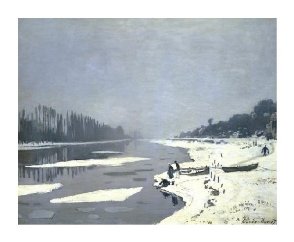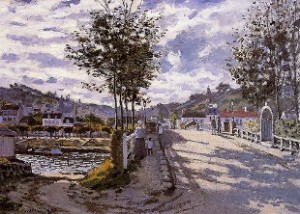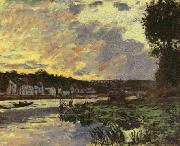Claude Monet
Claude Monet (1840-1926) is without doubt one of the leading impressionists. His name became associated with Bougival, where he painted many times, and with Giverny, a little further along the Seine where his house was situated.
“Ice Floes on the Seine at Bougival”, winter 1867-1868, oil on canvas 65×81 cm, Paris, Louvre Museum, Hélène and Victor Lyon Collection. This painting confirms the presence of Monet who came to paint on the spot about 15 kilometres from Paris.
Back in 1865 and 1866, Monet had already painted snow scenes around Honfleur and in Normandy where Boudin and Jongkind had incited him to paint in the open air. In this context, an article in the Journal du Havre of 9 October 1868 can be mentioned “we caught a glimpse of him, it was winter, during a few days of snow… It was bitterly cold. We noticed a small foot-warmer, then an easel, then a man wrapped up in three cardigans, wearing gloves, his face half frozen: it was Mr Monet, studying an effect of snow. ” These early snow scenes depicting roads were produced using sharp, vigorous brushstrokes and thick layers of paint.
In comparison, the painting “Ice floes on the Seine at Bougival“ » is more understated: figures and other details in the foreground are captured with brisk, precise brushstrokes which bring to life the people coming with their buckets to draw water from the Seine. The portrayal of the river and the background are handled with broad strokes of paint in almost monochrome hues which capture the cloudy, misty atmosphere of the winter landscape and create an impression of stillness and silence.
This painting should be compared to some of Whistler’s paintings that Monet may have seen, in particular “The Frozen Thames” an open air subject painted in 1860 and exhibited in Paris in 1867. The same monochrome fog effects can be found. These two artists had already been able to meet in the workshop of the Swiss painter, Gleyre, who was established in Paris and was training a number of painters including Renoir, Bazille and Sisley, the future impressionists.
“The Bridge at Bougival, or The Seine at Bougival”, 1869, oil on canvas 65×92 cm, Manchester, United States, The Currier Gallery of art.
In 1869, having settled in the hamlet of Saint-Michel in Bougival with Camille Doncieux and their son Jean, Monet decided to paint the bridge, inaugurated on 7 November 1858, which spanned the Seine and joined the Island of Croissy to Bougival. The painting’s careful composition, based on geometric lines, enhances the morning light which brings the lively scene to life: the small boat on the river with bluish reflections, the silhouettes of walkers brought alive by the large shadows cast by the trees and, in particular, the turning movement of the bridge road inviting us to leave the island and return to the village quays. Refusing to create a topographical picture, it is really the soft atmosphere of a sunny morning that the painter wants us to see, a snapshot taken on the way to La Grenouillère.
“The Seine at Bougival in the evening” 1869, oil on canvas, Smith College Museum of Art, Northampton (Massachusetts).
On a fine summer’s day, capturing the brightness of a colourful sky in which yellows, pinks and deep purples dominate, Monet depicts the magic of the countryside beside the Seine. Returning from La Grenouillère, where he painted with his friend Renoir, he stops to capture the sun’s last effects on the water where a small boat slides along in silence. On the other bank, a few houses just stand out against the line of the hillside forming the horizon which blends into the elegant architecture of the Marly aqueduct in the distance. The brushwork, which rapidly sketches out the vegetation in the foreground, does not omit to show us the light passing through the arches of the aqueduct, tiny pink spots, the first signs of night approaching.
With the “Grenouillères”, this painting concludes Monet’s Bougival period.
Note on Claude Monet’s English period
In autumn 1870, when Monet and Pissaro went and took refuge in London to escape the Franco-Prussian war, they were able to discover the art of Turner, whose paintings were exhibited in the National Gallery. Monet’s encounter with Turner’s work was to become one of his reference points until the end of his career, mainly with respect to his search for the fleeting effects of atmosphere and light. For example, it is worth mentioning: “Sun rising through Vapour” by Turner, exhibited from 1852 in the National Gallery, can be compared with “Impression, Sunrise” 1872-1873, a famous painting in the 1874 exhibition, which was a manifesto of the impressionist movement.




